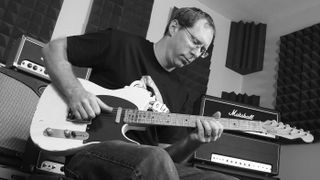The evolution of effects pedals is an incredible thing; there's not only a bewildering choice of wonderful stompboxes out there for guitarists to enjoy, but the very nature of pedal manufacturing has given small businesses a chance to make a huge impact on players and the market as a whole. It really deserves a film – and now we've got one with Reverb.com's ambitious and aptly-titled, The Pedal Movie.
Released today to purchase and rent, the long-awaited documentary is a fascinating insight into where effects pedals have come from and where they might be going. And it also highlights a number of inspirational people that are helping us guitarists sound better than ever; designers, visionaries and charismatic characters that make effects pedals the most exciting part of the industry.
The Pedal Movie is out now to rent or buy. For more info visit Reverb
Here's eight of our favourite discoveries from the film…
1. It sets a new standard
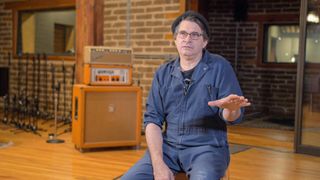
Before we get into anything else we need to say something about the production of this exhaustive two-hour 20-minute film; it raises the bar for the treatment of guitar gear in a documentary. We shouldn't be surprised, Reverb.com has form for high production values, but the pacing, level or access (they talk to a lot of people) and storytelling here are exceptional. Pedals finally get the story they deserve with a fully researched history and compelling pace but there's one problem… this film is going to make you want to buy more of them.
You have been warned.
2. We owe it to a happy accident

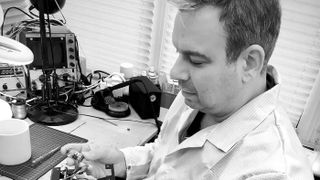
ThorpyFX's Adrian Thorpe and Dan Coggins answer our pedal questions
The film charts the evolution of effects chronologically and features George Snoddy early on – engineer of country singer Marty Robbins' Don't Worry (the b-side to 1961 single Like All The Others). The bass player was legendary Nashville session player Grady Martin and as JHS Effects founder / pedal history guru Josh Scott explains, he was using a six-string Danelectro six-string bass guitar plugged direct into a brand new mixing desk. Nobody knew that there were faulty transformers in it.
The resulting effect on Martin's bass sound causes a discussion – Robbins likes the "fuzz tone sound" that the fault gives the tone and so does engineer Glenn Snoddy. It's hard now to comprehend just how bold this sound was as the time and the reaction it received from listeners. Other engineers and artists then wanted the sound – including Nancy Sinatra.
Snoddy couldn't just rely on a faulty piece of equipment to replicate it and created a solution with engineer Revis Hobbs. The Gibson Maestro FZ-1 Fuzz-Tone was born in 1962. Retailing at $40 and the world's first distortion pedal.
3. There's plenty of player cameos
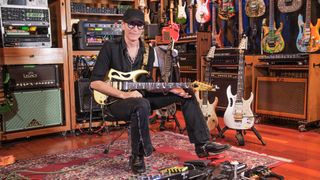
The first 25 minutes of the film are dedicated to fuzz pedals – and Billy Corgan pops up about talking about the Electro-Harmonix Big Muff. From then on there's some great tributes to be spotted as players recall their own key effects discoveries. Steve Vai and Dweezil Zappa hail the work of Frank Zappa in pushing the boundaries of sounds in his music.
Peter Frampton talks about his first encounter with pedal steel player Peter Drake's Talk Box. There's delay maverick Dave Knudson, session legend Dennis Coffey, Wlco's Nels Cline, J Mascis, Paul Gilbert talking Gilmour, Joe Bonamassa, Kevin Shields, Graham Coxon, Doyle Bramhall II, even drummer Patrick Carney from the Black Keys with his early Earthquaker Devices pedals… the list goes on.
It's great to see people like Corgan and Mascis play too (Graham Coxon even plays the Coffee And Tv solo on his Shin-ei fuzz) but they all have some interesting insights to share in addition to the manufacturing heroes interviewed here.
4. It looks at why boutique came back
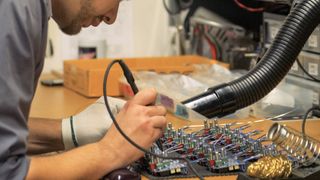
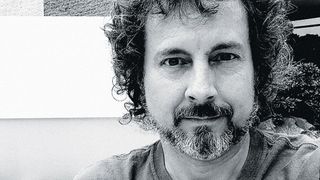
Tone makers - Analog Man's Mike Piera: "Almost every great guitar hero of mine has used my pedals"
The film tracks the huge steps made in the 1980s with digital effects and mass production but the resurgence of analogue and small team operations cannot be ignored – enter Tech 21's Andrew Barta and the SansAmp (he built the first unit in his kitchen and fellow boutique builders interviewed here including Analogman's Mike Piera, Z.Vex's Zachary Vex (who shows us the original Fuzz Factory), Way Huge's Jeorge Tripps, Strymon's Dave Fruehling, Robert Keeley, Jamie Stillman from Earthquaker Devices, Brian Wampler, Fran Blanche of Frantone Electronics and Joel Korte of Chase Bliss Audio.
Even key builders who aren't interviewed are given tributes including Jack Brossart of Prescription Electronics and the UK's one-man operation Dan Coggins of Lovetone. Alas, Mike Fuller gets credit from his peers for his work with pedals like the Fulltone OCD but doesn't speak here.
Josh Scott likens it to the shift from hair metal to grunge, and now we find there's plenty of room for both mass market and smaller scale hand-built effects brands. The winners are players with choice and accessibility.
As J Mascis points out, "When I was learning to play guitar I was learning to play effects at the same time." Only 25 years ago, this writer had to travel far from his home town to seek out a distortion pedal (I eventually got a used Shred Master that I regret selling on later to this day!) and it seemed like the keys to another world at the time. The fact players can choose from a huge range of incredibly diverse effects so easily now is due to the contributions of the designers showcased here.
5. J Mascis has a great quote

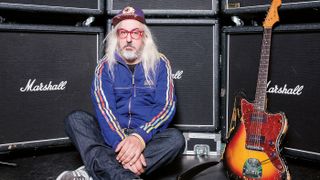
There's a great section halfway through the two-hour film about the alternative and grunge scenes of the early 1990s. The Dinosaur Jnr man embraced older school effects as the band achieved success in the 1990s and he's no snob, with little no time for the chinstroker approach to 'transparent overdrives'…
"I knew I liked fuzz for sure, and noise," says Mascis. "I never understood subtle effects like, 'Oh this is transparent'. It was like, why would you turn it on then? I don't understand. That always baffled me."
Never change, J!
6. Craig Anderton and RG Keen inspired the pedal community

Craig Anderton's 1980 book Electronic Projects For Musicians made schematics accessible to a generation that would go on to be pedal builders. It fuelled a DIY mindset that is crucial to the effects pedal industry.
"I think the guys I was learning from, they grew up with that Craig Anderton book," says Brian Wampler. RG Keen was another key figure with his work on Usenet; a pioneer for putting schematics on the internet that would-be builders could follow. Wampler even paid it forward with his own self-published book, How To Modify Guitar Pedals
The sharing of knowledge is key to any community, and for pedals the evolution of the internet has amplified that massively… pardon the pun. It's no coincidence the amount of pedal companies exploded with internet's growth. Josh Scott has a great term for it in the film – "The speed of knowledge".
7. The future's bright
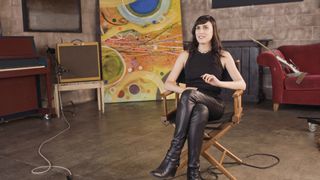

The last third of the film includes a look at the current state of the effects market – the brave new sonic worlds explored by brands like Earthquaker Devices, Walrus Audio and Death By Audio and the place pedals have in guitarist's lives now; pedalboards are a rule rather than an exception and bands like Radiohead and The Mars Volta have seen players effectively manipulating effects onstage like they're instruments in themselves. Alternative music has fuelled the pedal market and in turn those niche effects drive songs.
The boutique side of the industry has also proved incredible resilient – not bad for hobbyists who found themselves becoming businesses. And that passion is perhaps at the core of the success because it continues to attract players. With the advent in pedal demos that Andy Martin helped trailblaze online proving a hugely effective platform for players to explore.
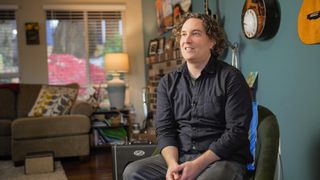

Where do we go from here? The film looks at that too and it's an exciting destination. The variables of components are still being explored – the subtleties allowing for a huge array of pedals exploring the same effects. And then there's digital signal processing.
Brands like Meris, Strymon, Source Audio, Line 6, Walrus Audio and Chase Bliss have opened even more doors for pedals with DSP. Now exploring how aligning the worlds can explore the 'flaws' and variables of analogue that some players want. That's why we're seeing so many incredible pedals in the last few years.
Some pedals will expand what players can do, expanding what musicality is. Some will always favour the more transparent and tasteful school of thought. And that's the best thing about pedals, there really is something for everyone.

The film also looks at the highs and lows of social media marketing that has allowed more competition in the market. And while forums once helped the DIY community to thrive, there's now a darker underbelly.
On a more positive note, it's great to see The Pedal Movie shine a light on women and minorities in the industry; looking frankly challenges they've faced from discrimination and the slow changes we're seeing in guitar culture, and in wider society.
8. And yes THAT pedal appears

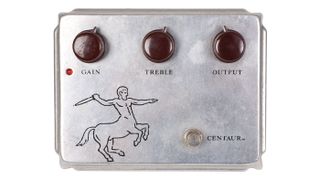
We got to just over the two hour mark without it being mentioned but the Klon Centaur overdrive pedal rears its mighty hooves. This would probably make a fine subject for its own documentary, and unsurprisingly the elusive Bill Finnegan doesn't weigh in here. It leads to an interesting discussion on klones and derivative effects.
But originality continues to thrive in the pedal industry – and the conclusion we get from The Pedal Movie are that effects makers continue to support each other but want to keep raising the bar. And that can only be great news for musicians.
The Pedal Movie is out now to rent or buy. For more info visit Reverb
